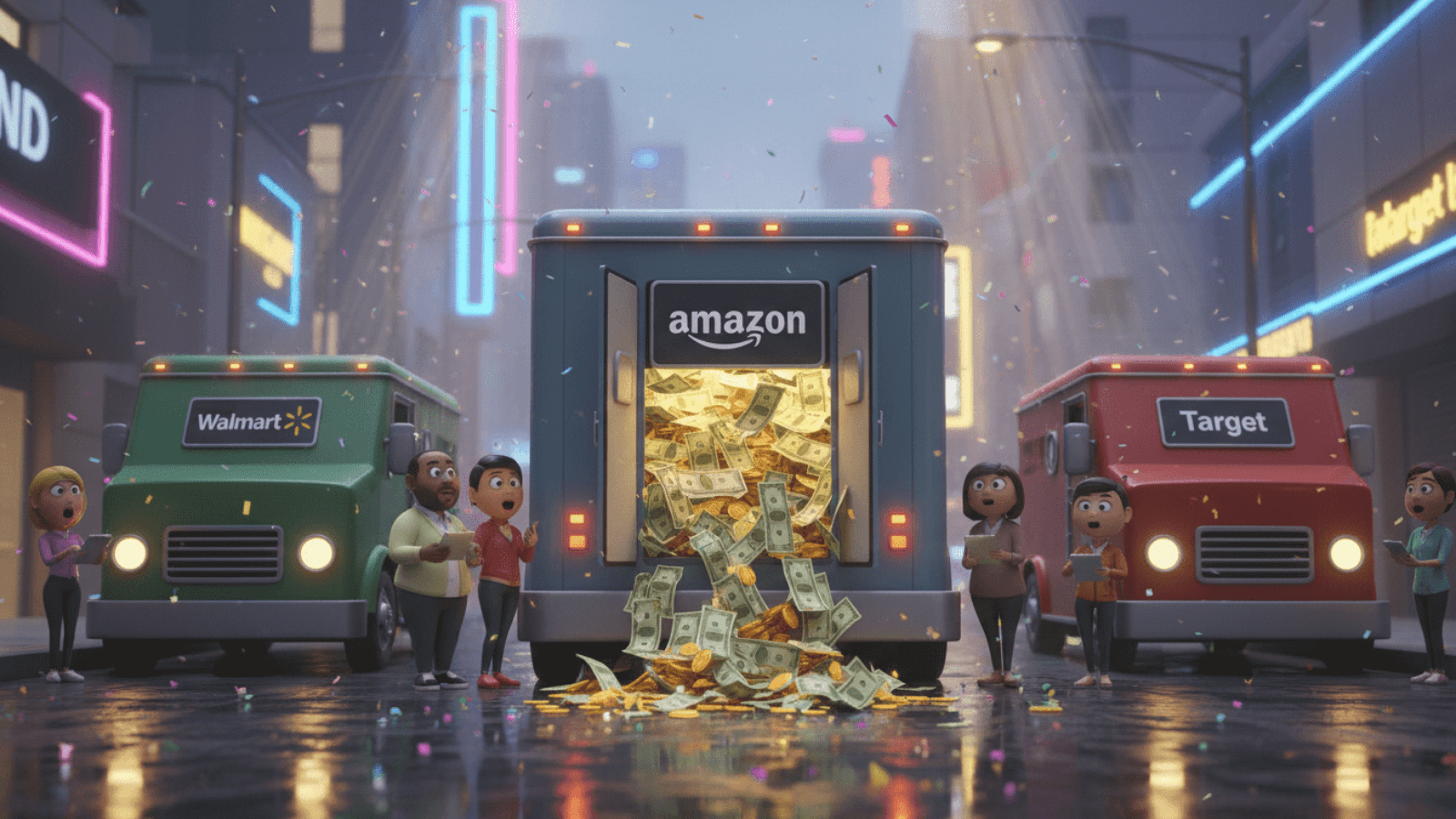
Amazon’s October Prime Big Deal Days (October 7-8, 2025) just wrapped up, and if you’re a brand selling through Amazon or supplying major retailers, the results should impact your Q4 strategy immediately. The event generated $9 billion in online spending, up 6.2% from last year’s $8.47 billion. That’s moderate growth in a challenging economic environment, and it reveals which strategies are working and which aren’t.
Walmart and Target both launched competing promotions during the same window, Walmart Deals (October 7-12) and Target Circle Week (October 6-12), but the results tell a stark story about promotional effectiveness. While Amazon saw a 61% average lift over baseline during the two-day event, Walmart’s sales remained essentially flat despite launching on the exact same day, and Target achieved only a 6.5% lift across its week-long promotion. Transaction data shows Amazon captured most of the incremental demand, even as shoppers compared prices across all three retailers before purchasing.
The most critical insight for brands is this: promotional depth matters more than promotional presence. Simply participating in these tentpole events isn’t enough anymore. Your competitors are offering aggressive discounts, flexible payment options, and seamless mobile experiences. If your pricing strategy doesn’t reflect genuine value, you’ll get passed over. Consumers compared prices across multiple retailers this year more than ever, and they’re willing to wait for better deals. That means your margin strategy needs to account for deeper discounts during peak periods, or you risk sitting on inventory heading into January.
If you’re selling across multiple retailers, understand that Amazon’s promotional gravity creates a halo effect. Both Walmart and Target saw measurable traffic increases during Prime Big Deal Days, with some shoppers converting at competing retailers after price comparisons. The conversion rates weren’t comparable, Amazon’s ecosystem advantages in Prime membership, personalization, and checkout friction reduction created winner-take-all outcomes. Your omnichannel strategy needs to account for this reality: plan your deepest inventory and most aggressive promotions for Amazon during these windows, while using Walmart and Target to capture spillover demand with synchronized secondary promotional efforts.
Mobile commerce hit 50.5% of total sales, which has direct implications for how you present your products. Your product detail pages, images, and A+ content need to be optimized for mobile-first experiences. If your listings aren’t converted on smartphones, you’re losing half your potential revenue. This isn’t just about responsive design, it’s about load times, image quality on small screens, and streamlined checkout processes. Audit your mobile conversion rates now before Black Friday hits.
Buy Now, Pay Later drove $723 million in transactions during the event, up 8.1% year-over-year. If you’re not integrated with BNPL providers like Affirm, Klarna, or Amazon’s own payment plans, you’re creating friction at checkout. For higher-ticket items especially, BNPL has become a conversion necessity, not a nice-to-have. Brands that enable these options are capturing sales that would otherwise go to competitors.
The product categories that performed best were electronics, home goods, and everyday essentials. Discretionary and luxury items underperformed. If you’re in a category that’s not considered essential, your promotional strategy needs to work harder to justify the purchase. Bundle deals, limited-time offers, and value-adds become critical for moving non-essential inventory.
Looking at Q4, Prime Big Deal Days is your preview for Black Friday, Cyber Monday, and the full holiday season. The 6.2% growth rate tells you that consumer spending is there, but it’s conditional. Shoppers are being selective, which means your assortment planning needs to be ruthless. Stock deep on proven sellers and cut back on experimental SKUs. Promotional budgets should prioritize high-velocity items that can drive volume, not margin-rich products that might sit.
If you’re planning inventory for November and December, assume that promotional intensity will be higher than last year. The brands that win this holiday season will be the ones that planned for aggressive discounting, optimized for mobile, enabled flexible payments, and maintained stock levels through peak demand. And critically, they’ll be the ones who understand that Amazon’s promotional calendar now dictates the entire retail landscape, even when competitors launch simultaneous events, Amazon’s ecosystem advantages create disproportionate outcomes that require strategic prioritization in your channel mix.
For brands looking to deepen their retail intelligence and identify new distribution opportunities, Chain Store Guide provides comprehensive retail data and contact information across all major channels. Understanding which retailers are growing, where they’re opening new locations, and who the key buyers are can give you a competitive edge heading into 2026 planning cycles.
Sources:

December 19, 2025
So here we are, wrapping up 2025, and AI in B2B marketing has made the jump from “interesting experiment” tohttps://www.chainstoreguide.com.
December 12, 2025
Here’s something most B2B sales teams won’t admit: They’re scrambling right now. While everyone else is in holiday mode, thehttps://www.chainstoreguide.com.
November 26, 2025
Early consumer spending, persistent shutdown anxiety, and lackluster promotions converged to erase the holiday surge retailers and suppliers were countinghttps://www.chainstoreguide.com.